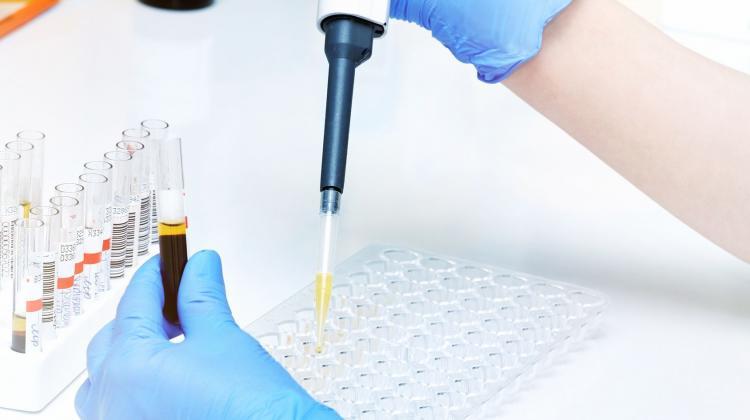Wrocław scientists are investigating the role of an important protein in melanoma cells and melanocytes
 Photo: Fotolia
Photo: Fotolia
Scientists from Wrocław conduct research on the role of gelsolin in human melanoma cells. In the future, the results of their research could help create new melanoma drugs or therapies, says lead researcher Dr. Antonina Mazur.
As part of a grant from the Sonata Bis competition financed by the National Science Centre, the biochemist from the Department of Cell Pathology at the University of Wrocław focuses on the role of gelsolin in the migration and adhesion of normal cells, including melanocytes and Schwann cells, as well as the role of this protein in cancer cells, primarily melanoma.
Gelsolin is an actin-binding protein present in cells. Actin is responsible for the shape of the cell and its ability to move.
In order for the cell to move in the body, it must first and foremost engage the actin cytoskeleton, explains the biochemist from the Faculty of Biotechnology, University of Wrocław. "The way this usually happens is that under the influence of appropriate signals, actin - which occurs in the cell in the form of a monomer, a single molecule - is able to polymerize, create long chains. This process is very strictly controlled and there are over 200 proteins, which directly interact with actin. One of them is gelsolin, which regulates the actin polymerization process" - explains Dr. Mazur.
This function of gelsolin has been known for a long time. But it turns out that this protein is involved in more than just the movement of cells. In recent years, Wrocław scientists in cooperation with the Ruhr University Bochum, Germany, were the first to study the expression profile of the gene encoding gelsolin in chicken embryos. The formation of melanocytes in chickens and humans is the same.
"Our research has shown that gelsolin is produced in particularly large quantities in cells originating from the neural crest. They give rise, for example, to pigment cells from which cancerous melanoma forms by neoplastic transformation" - explains the researcher.
In addition, this research has shown that there is a lot of gelsolin in the forming nerves of the peripheral nervous system, and that the protein can interact with other proteins that have not been linked to it until now. One of them is the non-integrin laminin receptor (LamR).
"Our research shows that the gelsolin-LamR interaction may be involved in the adhesion of melanoma cells to the extracellular matrix proteins. This interaction may also occur in normal cells during embryogenesis" - the researcher notes.
The role of gelsolin in the development of melanoma is unknown and it is unclear why this protein occurs in such large amounts in the cells of this cancer. Researchers admit that it appears that that depending on the type of cancer, the protein may inhibit or promote its formation.
"We still do not know how it is exactly in melanoma: whether gelsolin is needed for cancer transformation, or vice versa. We have our suspicions and we are checking this path" - notes the biochemist.
"For now we can say that if the gelsolin-coding gene is destroyed with the CRISPR/Cas9 gene-editing technique, then such cells adhere less to the substrate, which means that they move less well. In the case of cancer metastasis, the cells must have the ability to move. It would appear that cancer cells need gelsolin to move to distant corners of the body. But of course we still need to support these results with further research" - says Dr. Antonina Mazur.
She emphasises that this is basic research that should allow to understand what processes take place in cancerous and normal cells.
"If we understand what gelsolin does in melanoma cells, in the near future we might be able to use it to design new drugs that will lead to new therapies against melanoma. This cancer is quite difficult to treat, because in its case one cancer cell is enough for metastasis" - she notes.
The research of Wrocław scientists may contribute to expanding the knowledge about autism and schizophrenia. The researchers have shown that lowering the level of expression of the gelsolin-coding gene led to malformation (congenital defect) of the developing brain. Reports from other researchers known from the literature show that such diseases involve a change in the expression profile of the gelsolin-coding gene.
"These two facts - the discovery of our team and the fact that the gelsolin levels are changing in such diseases of the central nervous system - may, for example, help determine the causes of these diseases. Of course, further research is needed to determine whether changes in the level of gelsolin in the expression profile of the gene that encodes this protein contribute to the formation of these diseases, or they are just the results of their occurrence" - says Dr. Antonina Mazur from the University of Wrocław
PAP - Science in Poland, Kamil Szubański
szu/ zan/ kap/
tr. RL
Przed dodaniem komentarza prosimy o zapoznanie z Regulaminem forum serwisu Nauka w Polsce.


















